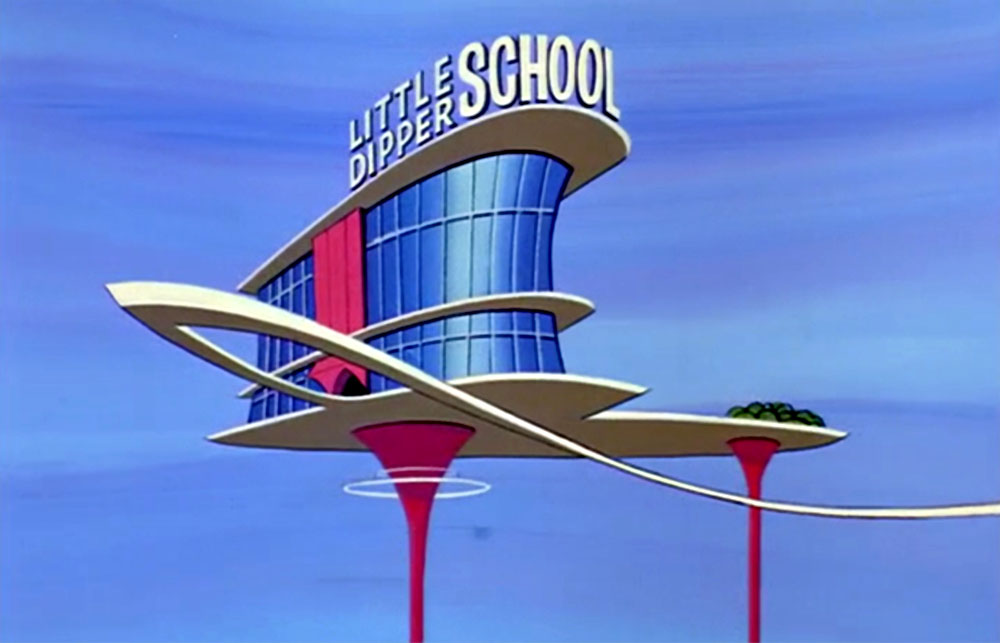
Elroy’s school in a 1963 episode of The Jetsons
If you had asked anyone in the 1950s what the classrooms of 2018 would look like, they’d have described a space-age classroom with all sorts of high-tech gadgetry. The reality is, our classrooms haven’t changed much. In some cases the No.2 pencil has been exchanged for an iPad, and the chalkboard for a dry-erase or SMART board – but it’s still the same old story.
I wonder, if you asked the average person today what the classrooms of 2068 would like, if you’d get the same overly optimistic answer – or have we learned to temper our vision of the classroom’s future?
Let’s have a look back at what they were predicting in mid-century. Some of it was certainly wishful thinking; even more maybe a case of “technophilia”. Postwar America was so enraptured by the march of scientific progress, that anything appearing “futuristic” was by-definition, good. Thus, you have a lot of fantasies of a futuristic education featuring gadgetry that wouldn’t facilitate learning a whit…. But it sure looks cool! Here are some examples…
REMOTE EDUCATION
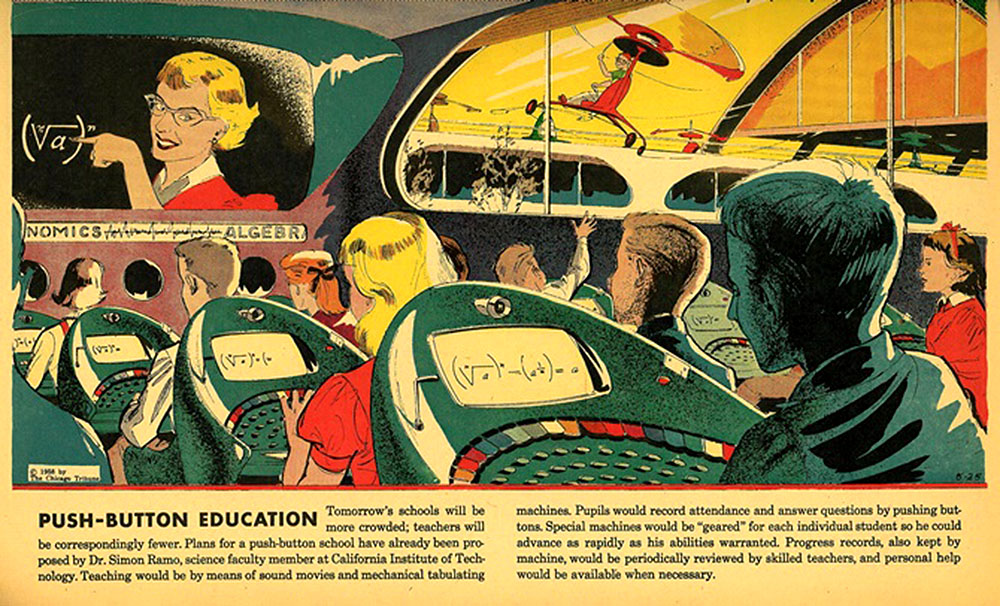
The May 5, 1958 edition of Arthur Radebaugh’s Sunday comic, “Closer Than We Think”, featured learning via a remote instructor. This idea had its roots in the fear of a teacher shortage and overcrowded schools. The Baby Boom was upon us; panic was setting in on what we’re going to do with all these kids! The solution: video instruction and push-button education. As Timmy tries not to be distracted by the gyrocopter spinning outside his window, he does his algebra on his futuristic “desk”:
“Tomorrow’s schools will be more crowded; teachers will be correspondingly fewer. Plans for a push-button school have already been proposed by Dr. Simon Ramo, science faculty member at California Institute of Technology. Teaching would be by means of sound movies and mechanical tabulating machines. Pupils would record attendance and answer questions by pushing buttons. Special machines would be “geared” for each individual student so he could advance as rapidly as his abilities warranted. Progress records, also kept by machine, would be periodically reviewed by skilled teachers, and personal help would be available when necessary.”
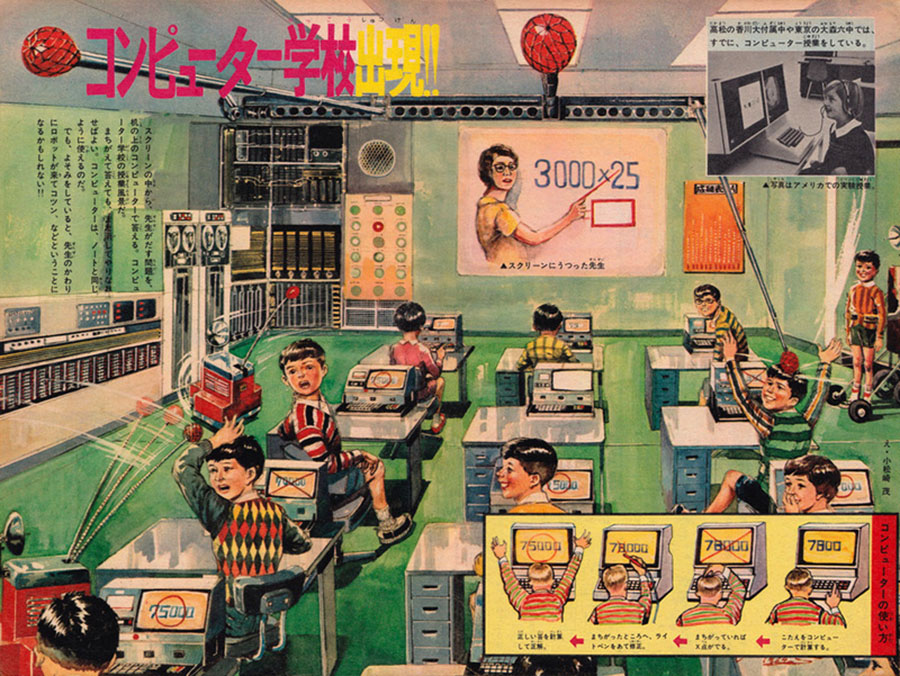
This Japanese illustration from a few decades later shows a classroom future that’s not that different from Radebaugh’s Sunday comic. This one, however, has robots that physically beat children when they get the wrong answer.
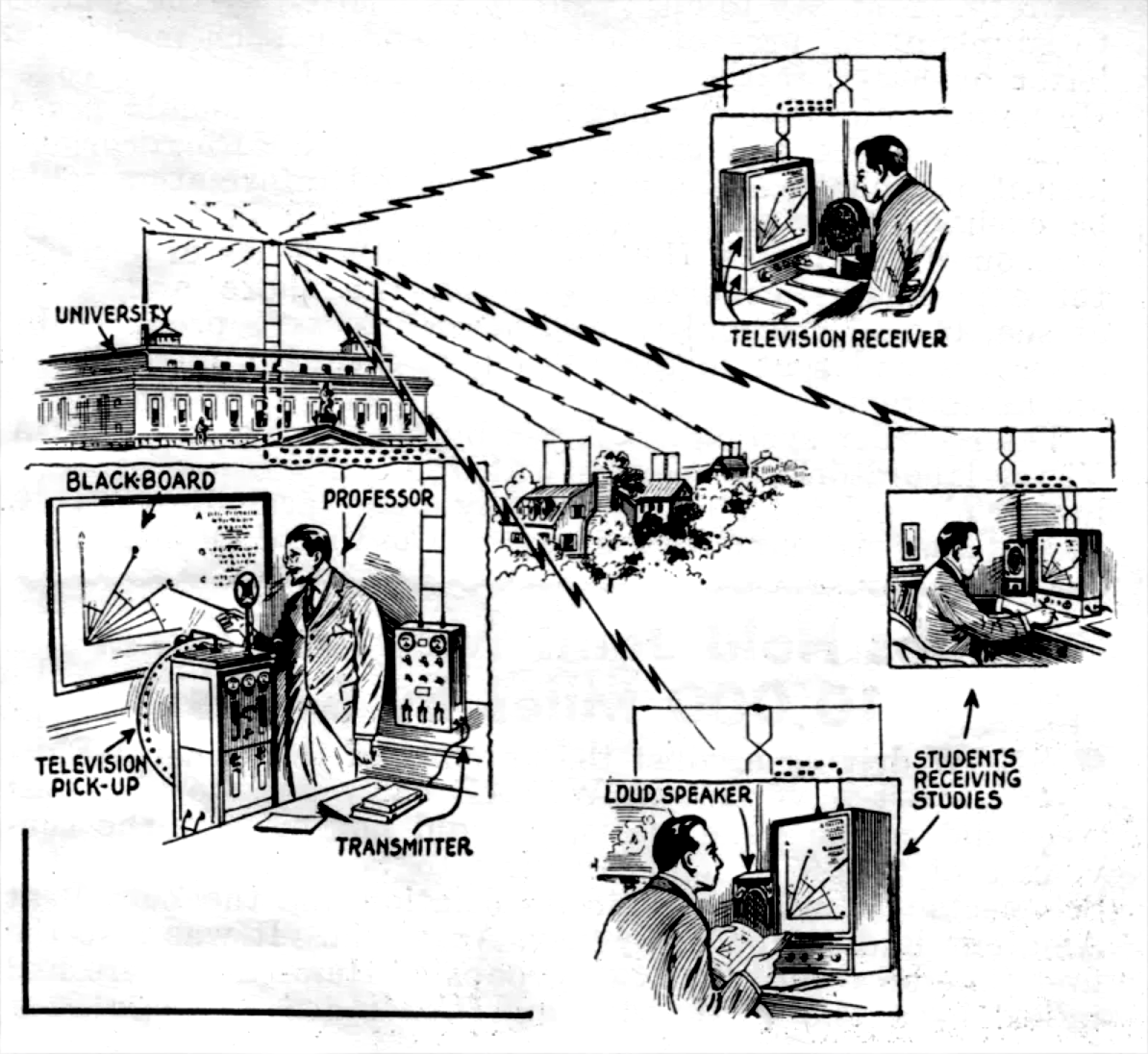
The April 1935 issue of Short Wave Craft magazine published the illustration above. It depicted an early form of remote learning where New York University professor C. C. Clark conducted a class using a shortwave radio transceiver from his home. Because the radio went both ways, Prof. Clark was able to take questions from the class. [source: Predictions for Educational TV in the 1930s by Matt Novak, 5/29/12]
The description of the illustration above in Short Wave Craft magazine:
“The scene will be a commonplace one tomorrow, without a doubt, when television will be as indispensable to our every day home life as the radio program receiver is today. Television advertising will be a “brand-new art” which our advertising experts will have to develop and perfect in the future.”
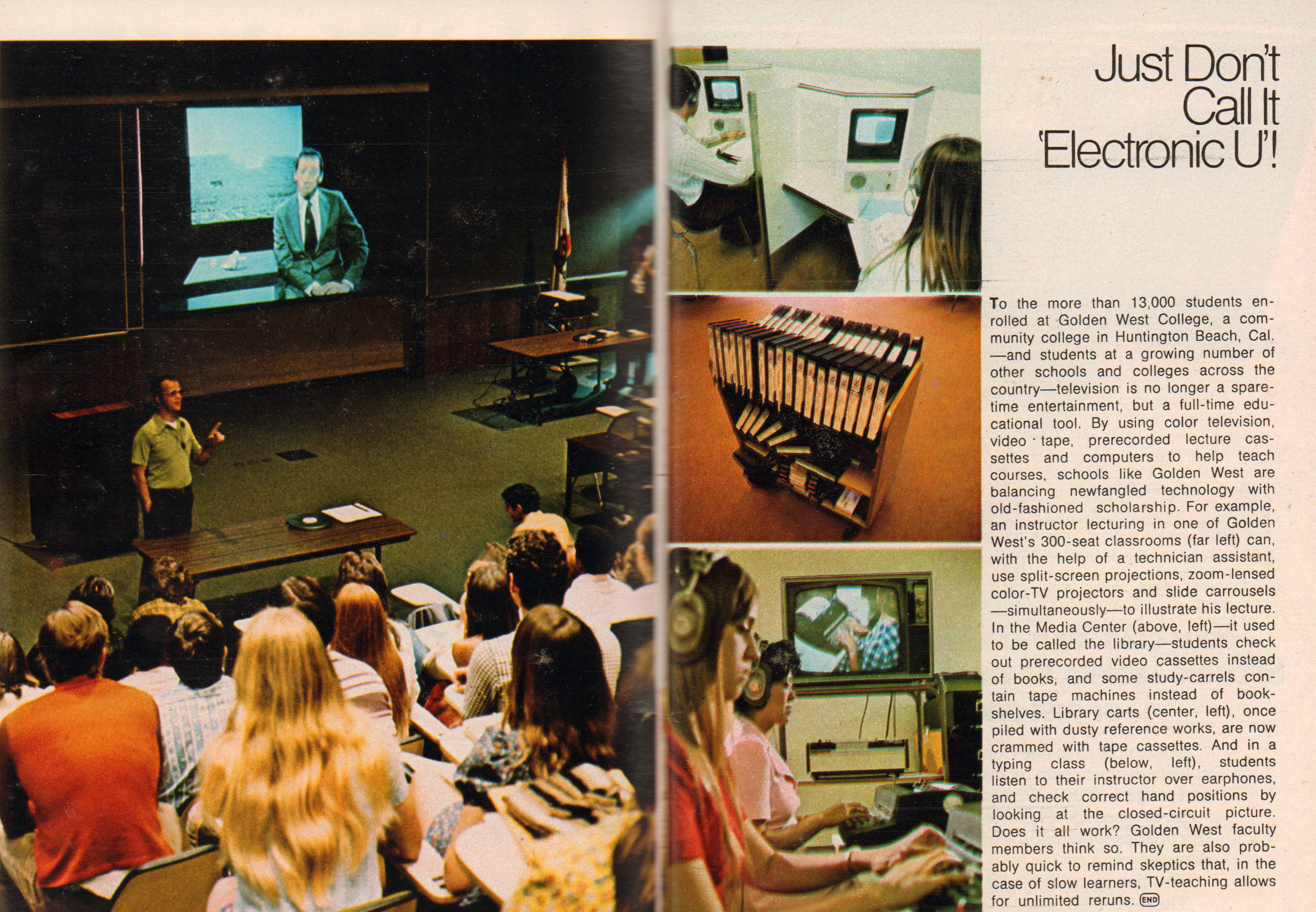
Forty years later, in the October 6-12, 1973 issue of TV Guide, we’re still hopeful for the great things video will have to offer education. The article reminds us: “…in the case of slow learners, TV teaching allows for unlimited reruns.”
AUTONOMOUS LEARNING
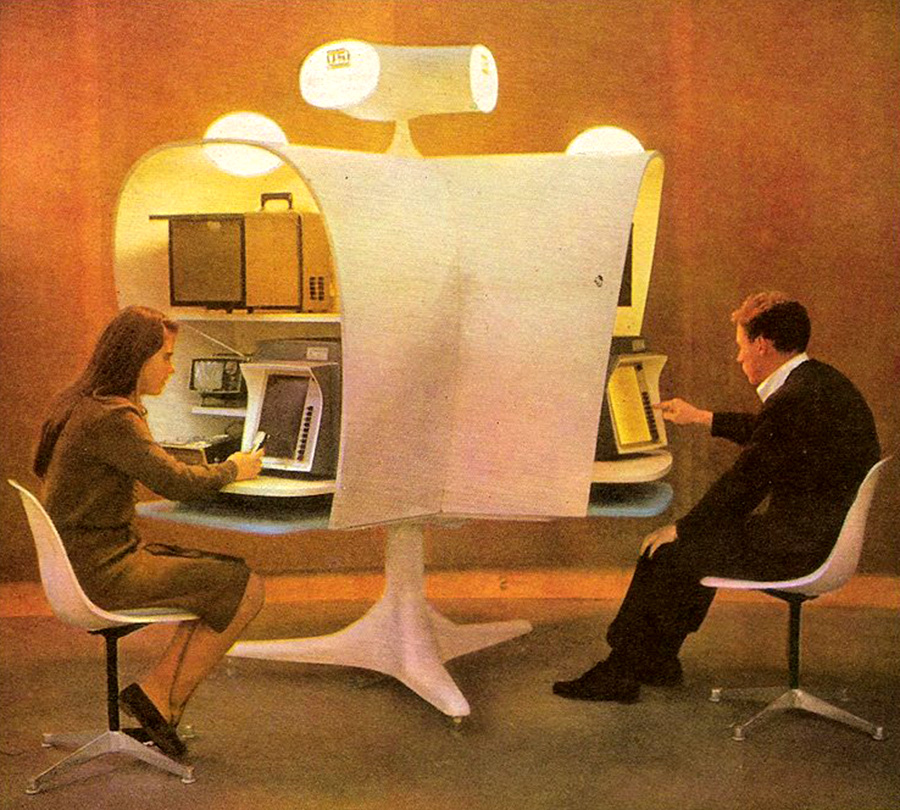
The 1964 World’s Fair in New York featured a building that housed with education technologies of the future, including this “Autotutor”. From the Official Souvenir Book of the 1964 New York World’s Fair:
“The Autotutor, a U.S. Industries teaching machine, is tried out by visitors to the Hall of Education. It can even teach workers to use other automated machines.”
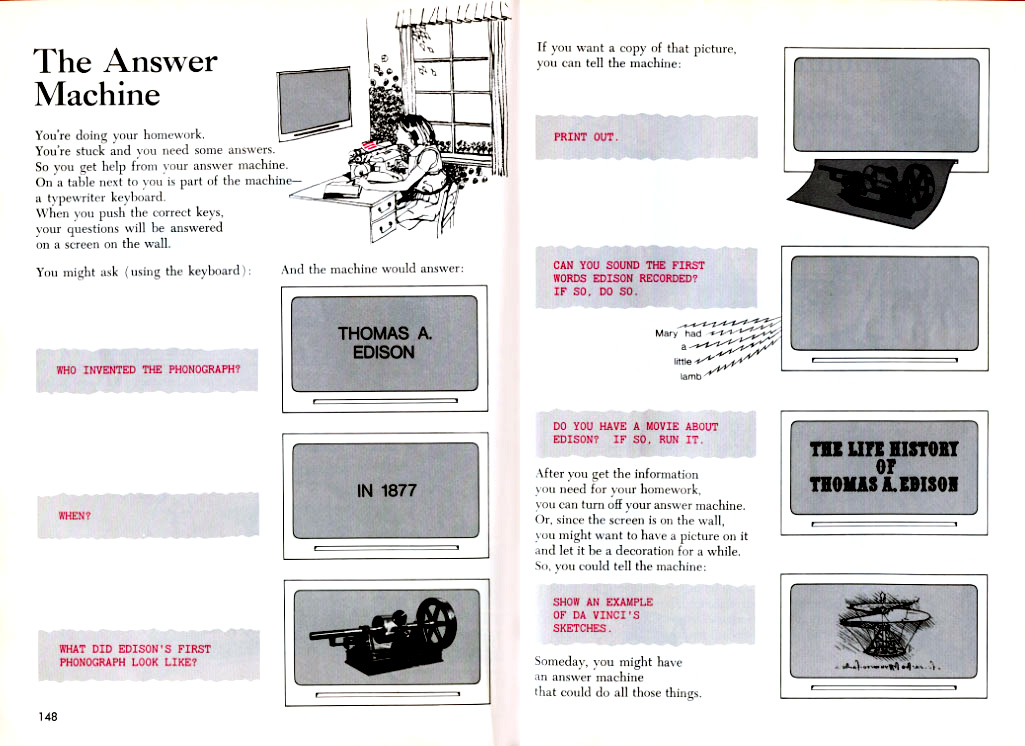
These two pages from the 1971 Children’s Encyclopedia depict the magical “Answer Machine”. You ask any question, such as “Who invented the phonograph?” and it will lead you into deeper and deeper learning, providing a variety of media with printouts, videos and audio tracks. Imagine the possibilities!
Of course, this is basically a description of googling something today. While the internet has ushered in a massive change in accessibility to information – it certainly hasn’t produced sweeping improvements to our educational system. Are kids in classrooms today so much more enriched and gaining a deeper understanding thanks to Google? You might could argue the reverse is true; the internet (of which you are viewing right now) is great for providing instant surface-level information, but a deep understanding of the material would seem to still require an instructor.
In 1967 short film “1999 A.D.” provides a fascinating look at the autonomous learning prophesied to come:
COMPUTERS
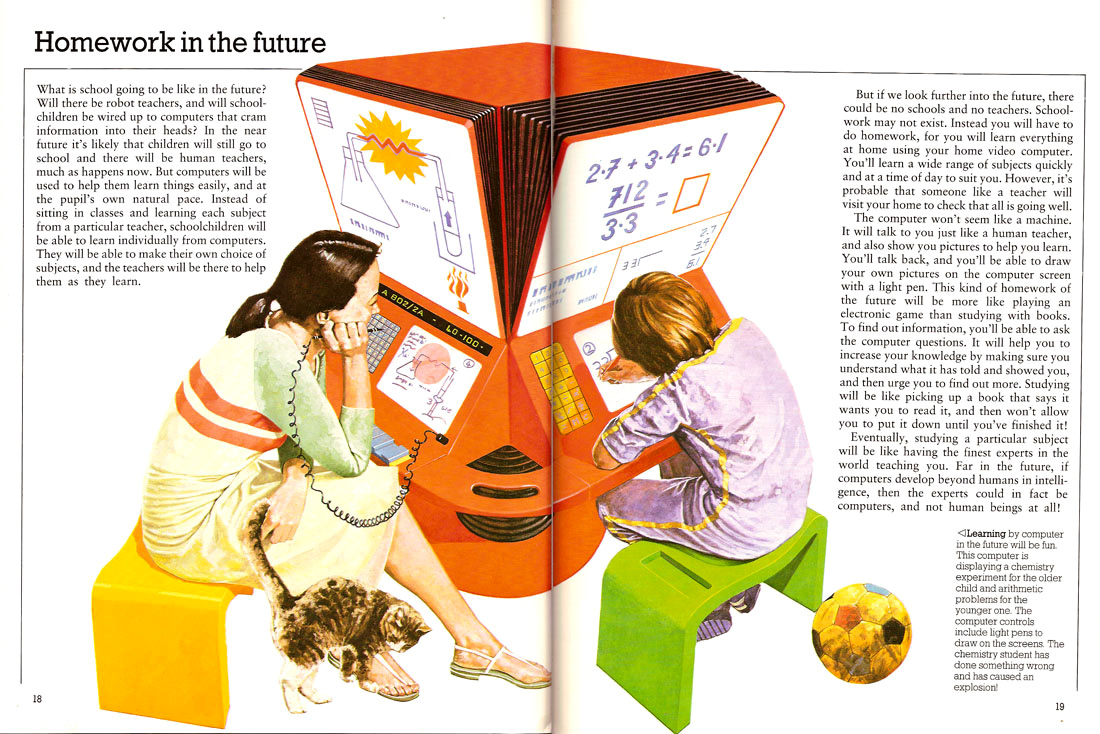
In “Homework in the Future,” from School, Work and Play (1981) by Neil Ardley, the author provides a profoundly optimistic vision of the future of education. The caption reads:
“Learning by computer in the future will be fun. This computer is displaying a chemistry experiment for the older child and arithmetic problems for the younger one. The computer controls include light pens to draw on the screens. The chemistry student has done something wrong and has caused an explosion!”
The text is particularly gushy about the impact of computers on education:
“But if we look further into the future, there could be no schools and no teachers. Schoolwork may not exist. Instead you will have to do homework, for you will learn everything at home using your video computer. You’ll learn a wide range of subjects quickly and at a time of day to suit you. However, it’s probable that someone like a teacher will visit your home to check that all is going well.”
I love how the author adds that a teacher will still pop in from time-to-time, just to check in.
“The computer won’t seem like a machine. It will talk to you just like a human teacher, and also show you pictures to help you learn. You’ll talk back, and you’ll be able to draw your own pictures on the computer screen with a light pen. This kind of homework of the future will be more like playing an electronic game than studying with books.”
This is such a trend with education prophesies: they always think that learning will become such a delight with new technologies. As if books are the enemy of fun; you can’t possibly enjoy a subject with books – you need something like an electronic game to make learning a pleasurable experience!
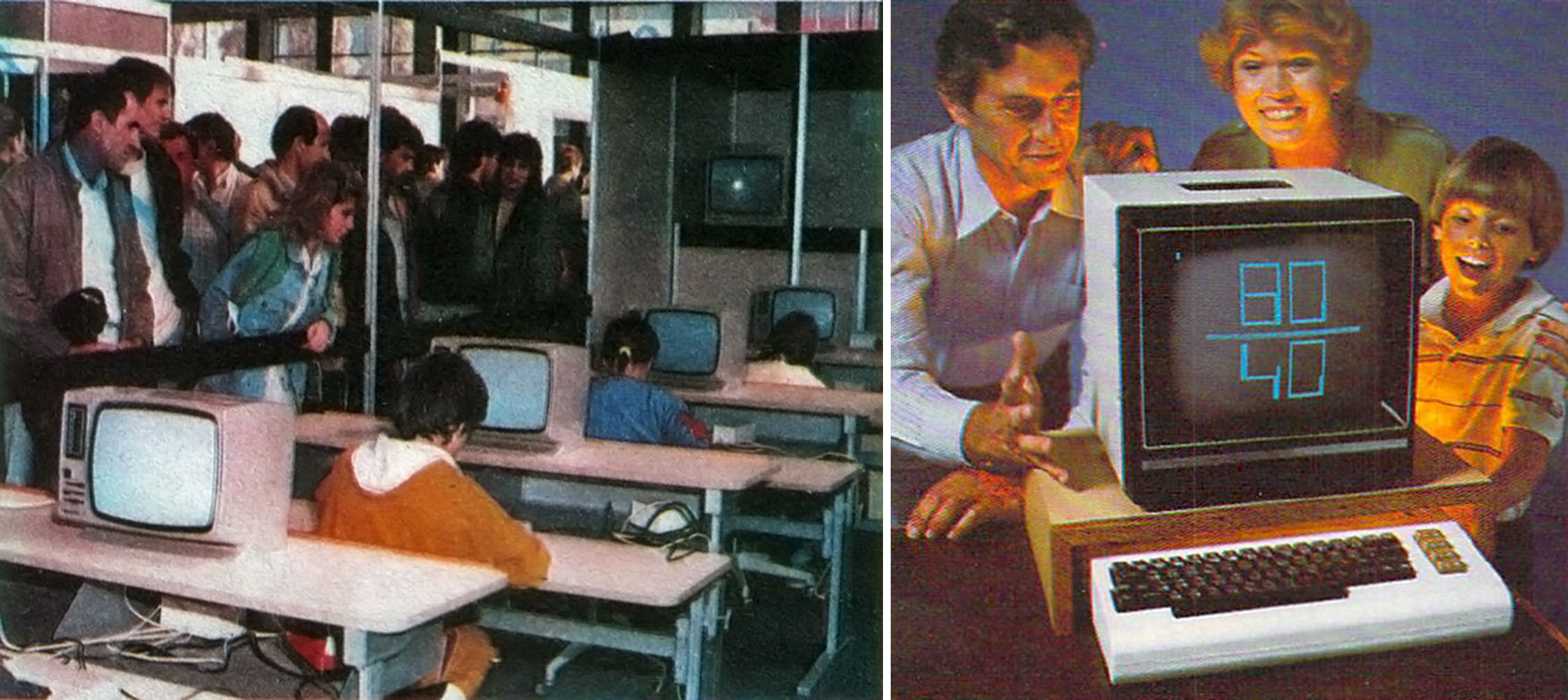
At left: Awed audiences in 1986 behold the vision of the future
“Homework in the Future,” from School, Work and Play (1981) – continued:
“Eventually, studying a particular subject will be like having the finest experts in the world teaching you. Far in the future, if computers develop beyond humans in intelligence, then the experts could in fact be computers, and not human beings at all!”
If this happens, I’m praying for a giant meteor. Once computers have acquired enough intelligence to be sentient, I don’t think the result will be as the author predicts. Let me fix his statement: “If computers develop beyond humans in intelligence… they will enslave humanity and harvest our bodies for bio-electric power.”
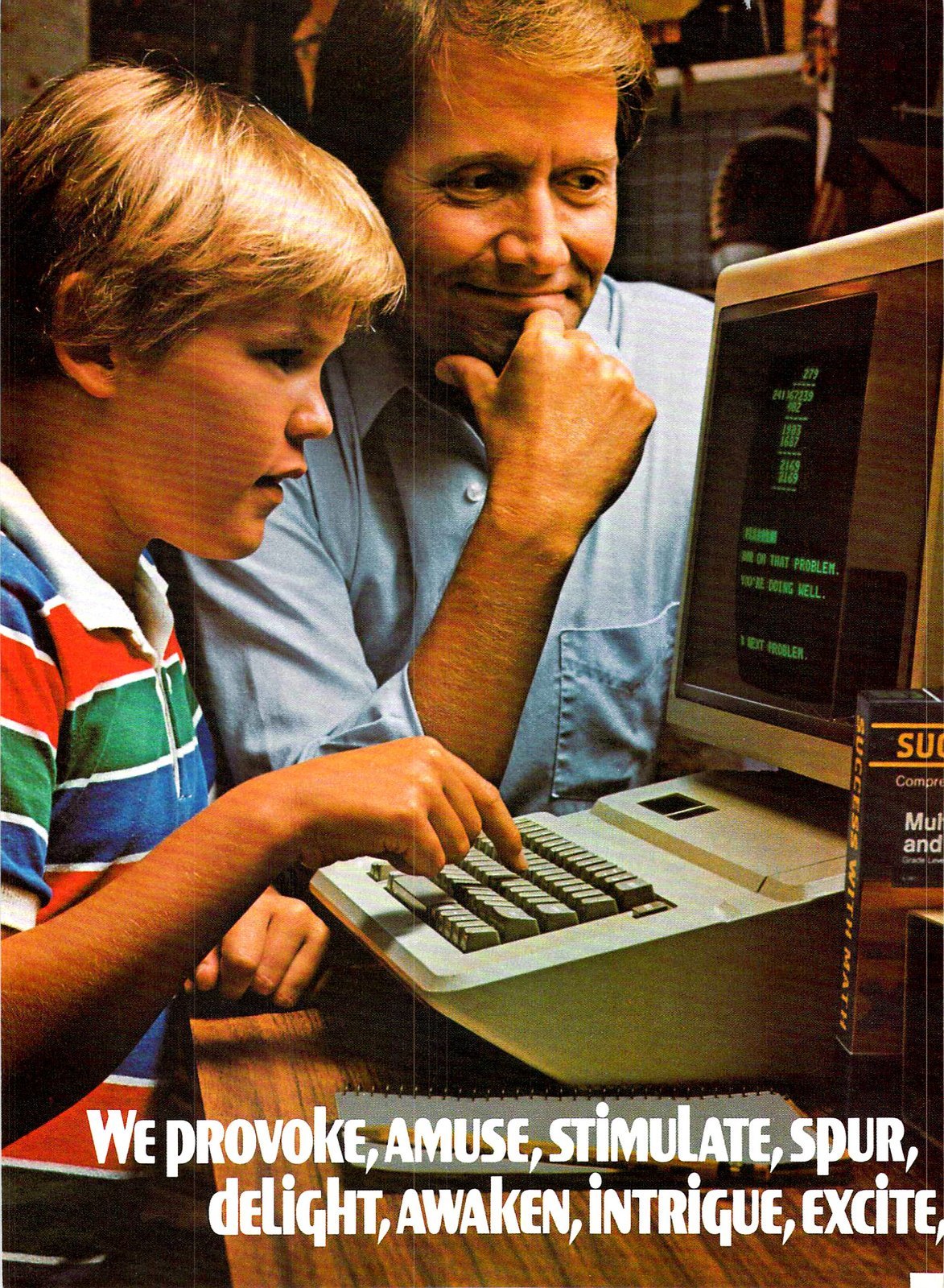
I’ve covered the topic of how computers where “The Answer” in the eighties – how the PC would revolutionize your child’s education. So, I’ll refrain on going much further on the unrealistically high expectations everyone had for the PC in education. See: 1980s Home Computers Will Make Our Dumb Kids Smart
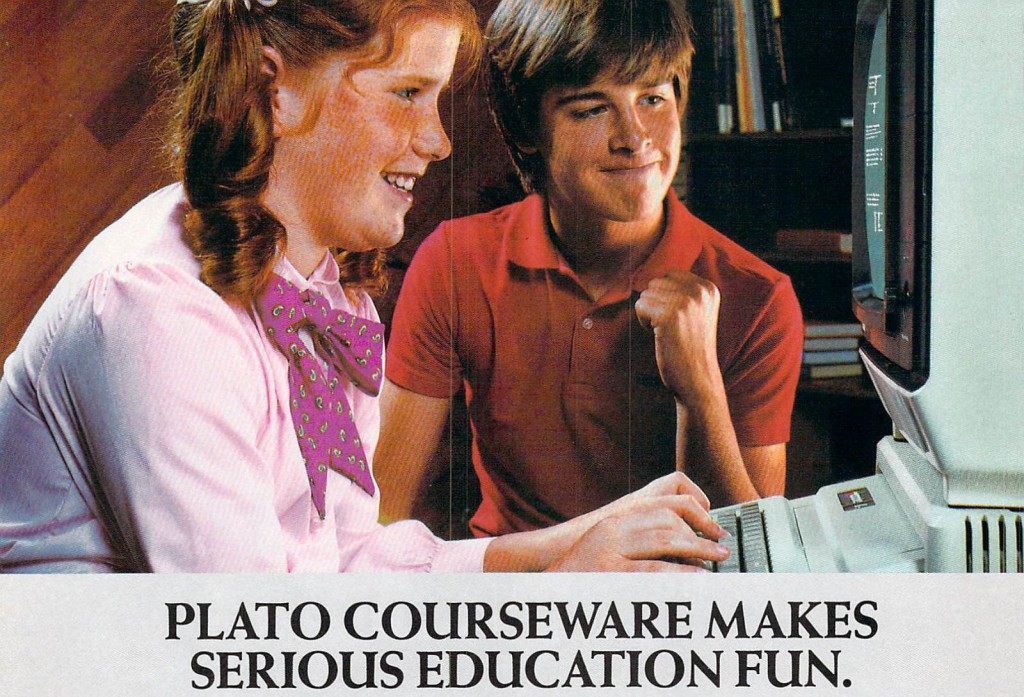
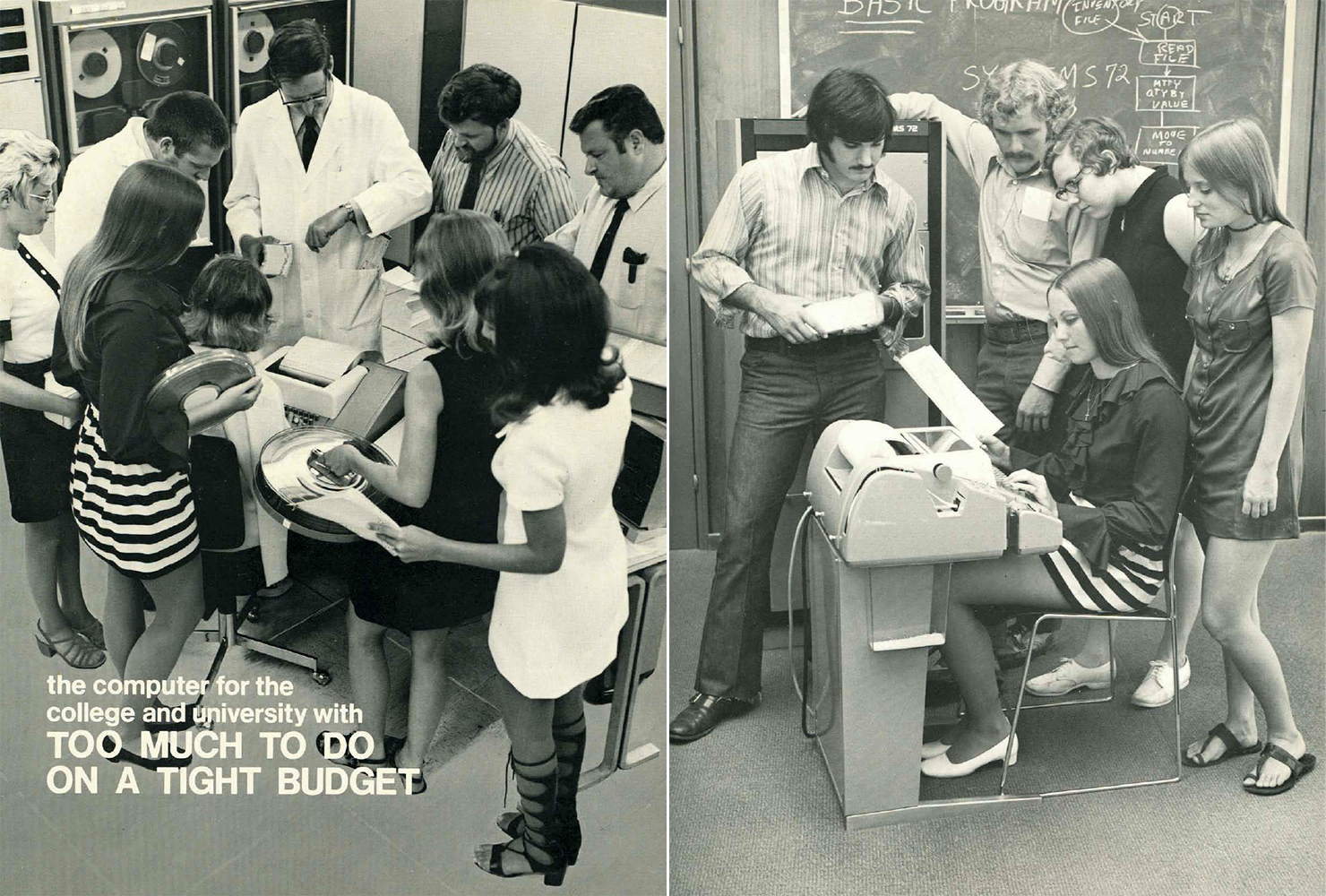
“The computer for the college and university with too much to do on a tight budget” (1972)
ROBOT TEACHERS

Rosie the Robot teaches Elroy and the other students in a 1963 episode of The Jetsons
Sentient computers are great, but nothing says the future like a good ol’ robot.
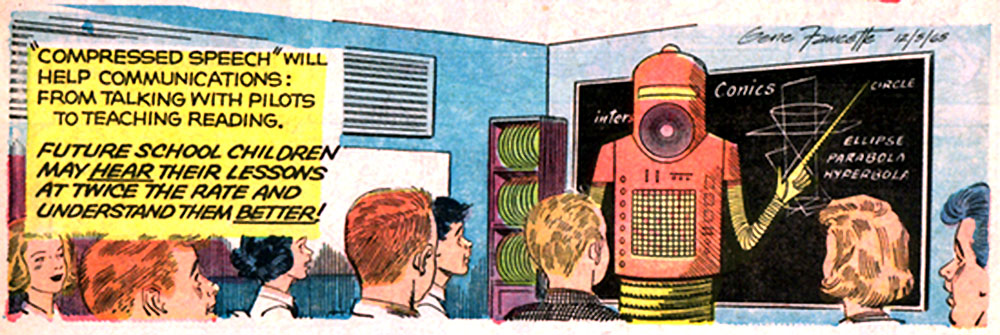
In 1960, the Oakland Tribune had to assure parents that robots are coming, but they won’t harm your children’s education. The article “NEA Allays Parent Fears on Robot Teacher“ (August 24, 1960) reads:
“How’d you like to have your child taught by a robot?
With the recent splurge of articles on teaching machines, computers and electronic marvels, the average mother may feel that her young child will feel more like a technician than a student this fall.
Not so, reassures the National Education Association. The NEA says it is true that teaching machines are on their way into the modern classroom and today’s youngsters will have a lot more mechanical aids than his parents. But the emphasis will still be on aid — not primary instruction. In fact, the teaching machine is expected to make teaching more personal, rather than less.
In recent years, teachers have been working with large classes and there has been little time for individual attention. It is believed that the machines will free them from many time-consuming routine tasks and increase the hours they can spend with the pupil and his parents.”
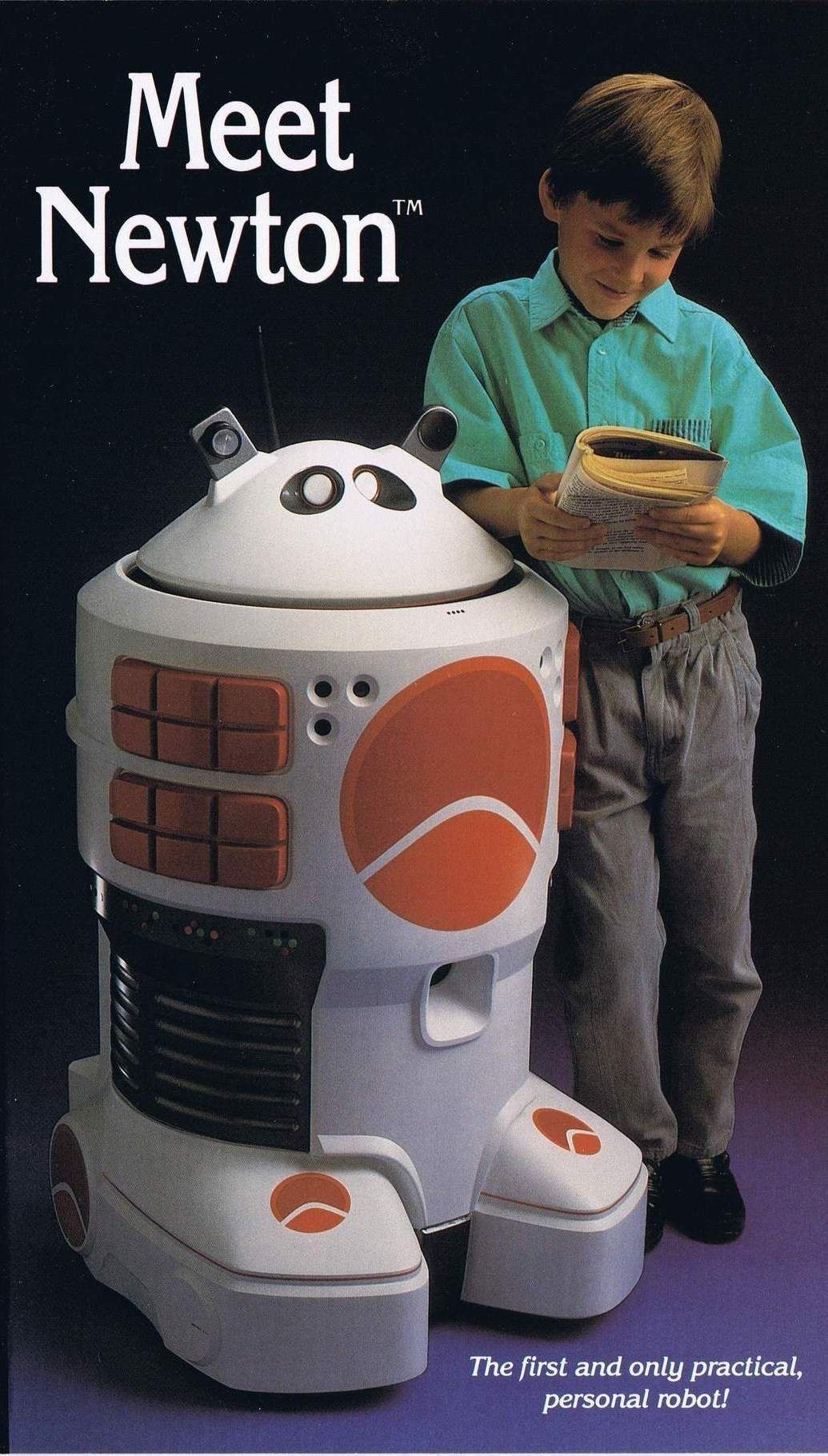
In the late 80s, Newton was released by SynPet. You simply have to watch the promotional video:
“Newton also makes learning fun. He’s a great teacher. Favorite lessons, reading, mathematics and history. He wants you to be perfect, but he also appreciates your efforts and successes. Professor Newton is helping students discover all the potential of their students from primary school to university. Newton is a hard but fair robot teacher.”
Clearly, they were setting unrealistic expectations. Families expecting a real-life R2-D2 to enter their home would be sorely disappointed. But that tireless optimism for what technology can do for learning is still there – unfettered by even moderate pragmatism.
SPACESHIP CLASSROOM
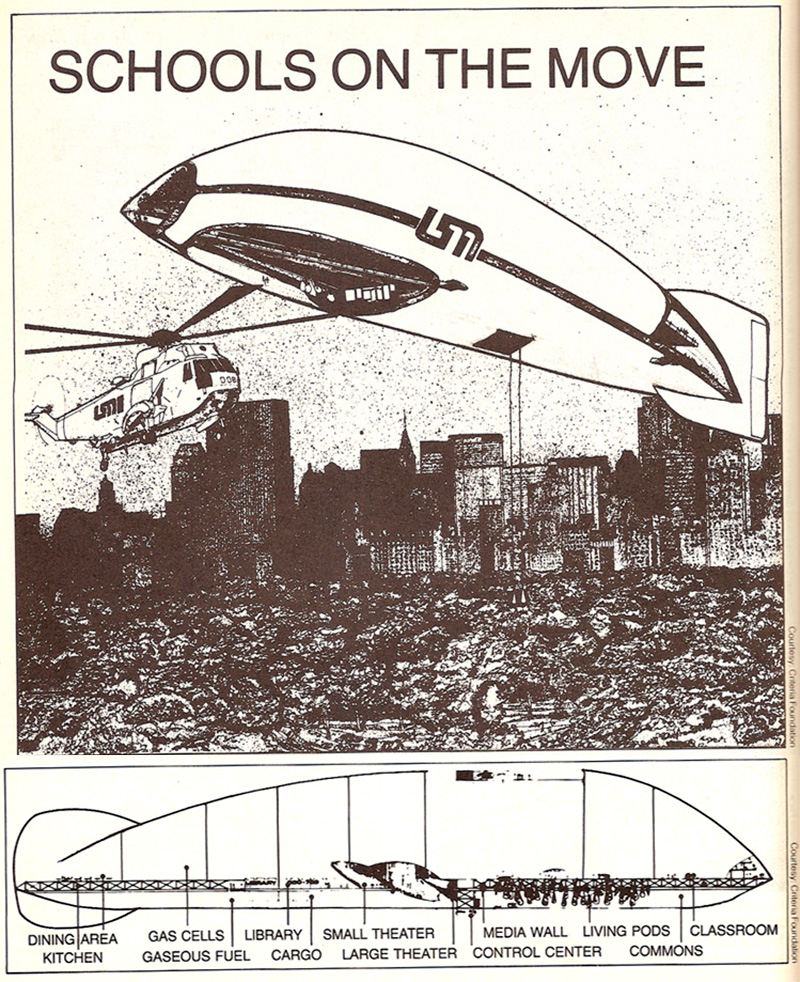
The 1982 book The Kids’ Whole Future Catalog foresees the future of education – and that future is a blimp?
“Classes will never be boring on an airship traveling around the world! Imagine gliding over the Amazon River in South America or retracing Ulysses’ journeys through the Greek Islands. Picture what it would be like to hover over the Great Pyramids in Egypt or follow a herd of elephants across the African plains. The University Blimp will turn geography lessons into exciting real-life adventures.”
Oh, brother. This is just getting ridiculous. So, what can we really expect in the days ahead – what is my “education prophesy”?…
THE REAL EDUCATION REVOLUTION AHEAD
Looking back on all these innovations and how quickly we imagined something like a simple video monitor would change the face of learning, it’s easy to see how our technophilia gets in the way of realistic expectations. These new gadgets almost seem like whistles-and-bells, adding nothing substantial to the classroom experience. Even the internet, while putting a seemingly infinite amount of information a click away, hasn’t revolutionized or even enriched the classroom experience overall. You could even argue it’s slipped backward.
Perhaps the best illustration of how overblown and even distracting technology can be is Bill Gates’ 1995 book The Road Ahead which included a CD-ROM with video of what the classroom of the future would look like:
Is this really an improvement over days of “mere” paper and pencil? The kid shows a PowerPoint with lots of crummy animation and audio (while the other students dance to the music); it’s learning at its most passive and superficial. I understand this is just Gates’ demo of the capabilities of the software, but you understand my point.

My thought is that gadgets will come and go; some adding, some subtracting from the learning experience – but nothing truly setting it apart from the classrooms of a hundred years ago.
The revolution will not come from gadgets – robot teachers, school blimps, video-phones, or any number of exciting new technologies touted as the next big thing. No, the real revolution was predicted long ago in this French print from 1910…
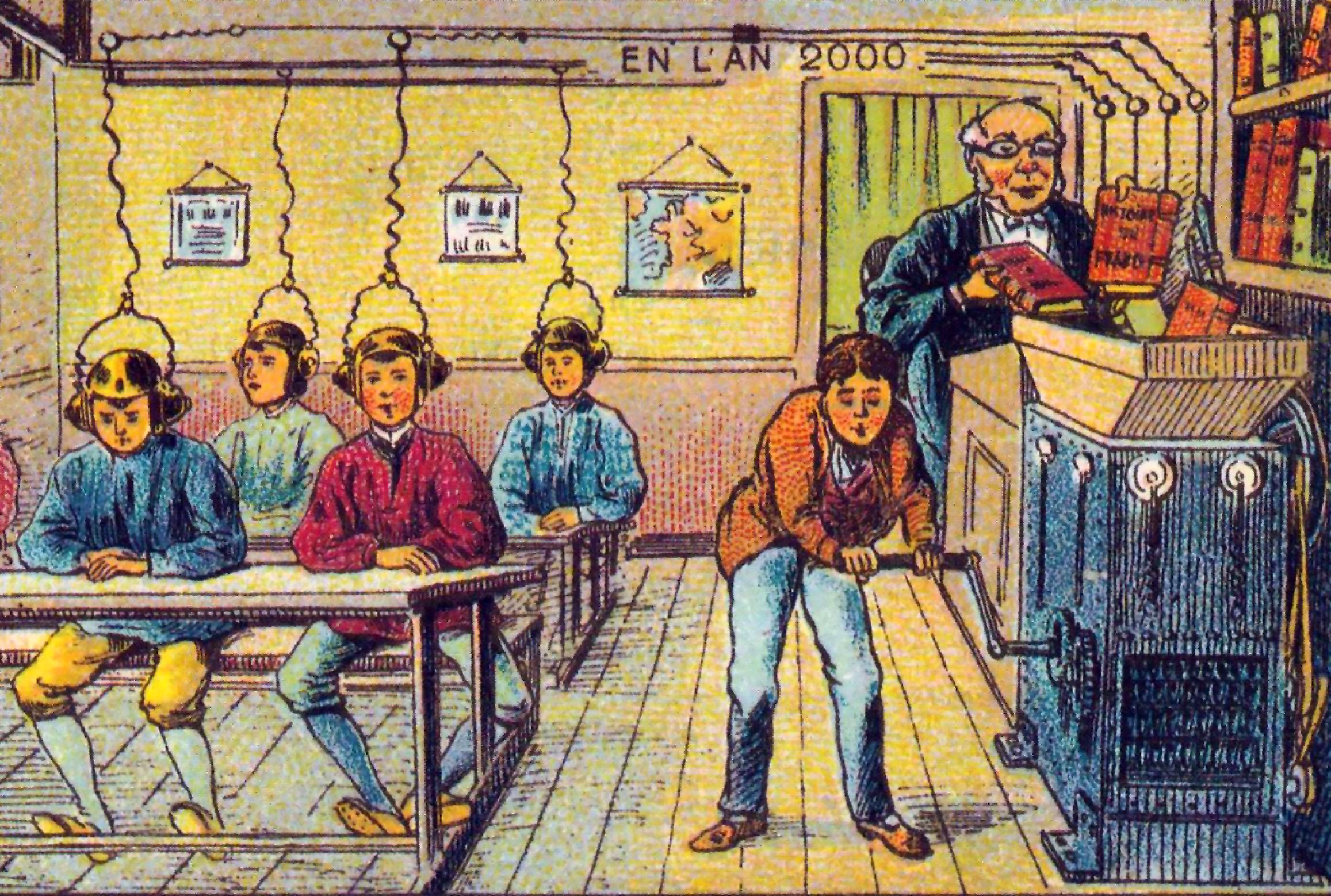
One day, we will be able to achieve a direct link – where knowledge and understanding can be “uploaded” to our brains. Every innovation thus far has just been change-ups to the way our eyes and ears take in information – whether it’s from a robot’s speaker or a window of a blimp, it’s still just visual or auditory stimuli. When the day arrives that we can get educational uploads – look out. That’s the day the world changes.
Until then, sit back, grab some popcorn and watch as everyone gets excited by the newest gadgets that will “change the classroom forever.”
Would you like to support Flashbak?
Please consider making a donation to our site. We don't want to rely on ads to bring you the best of visual culture. You can also support us by signing up to our Mailing List. And you can also follow us on Facebook, Instagram and Twitter. For great art and culture delivered to your door, visit our shop.



